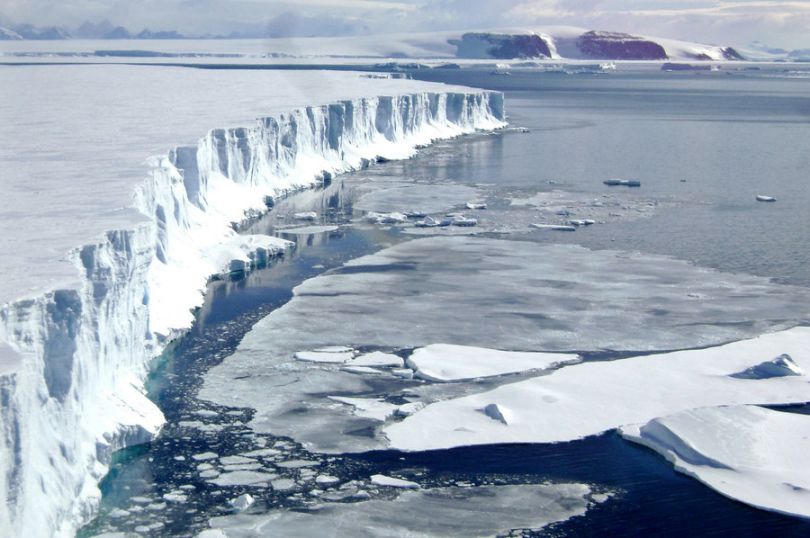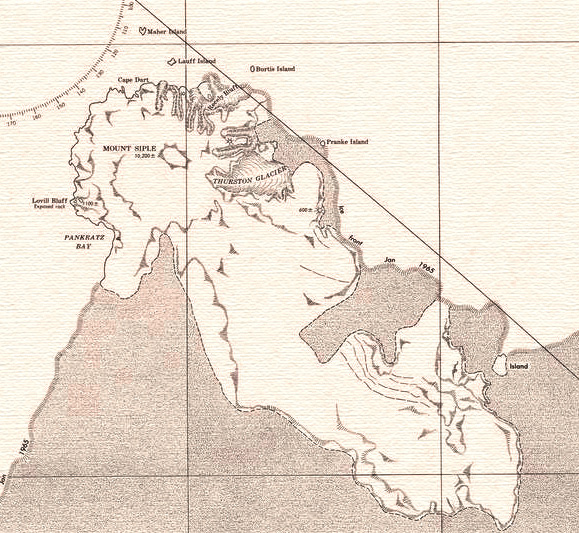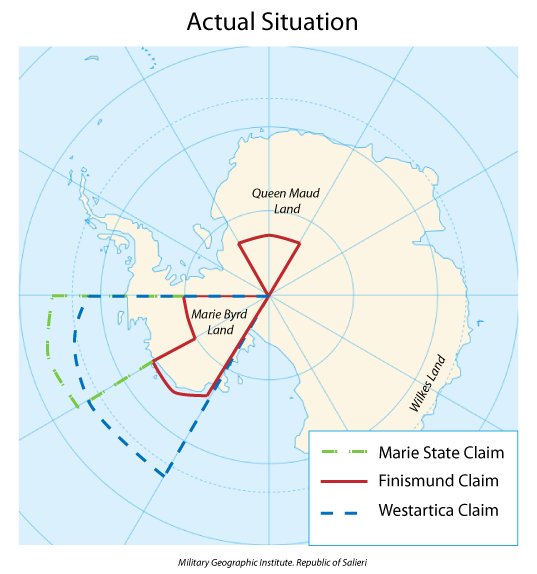Siple War
| The Siple War | |||||||
|---|---|---|---|---|---|---|---|
| |||||||
| Belligerents | |||||||
| Commanders | |||||||
|
|
|||||||
| Strength | |||||||
| 10+ | 2 | ||||||
| Injuries and Casualties | |||||||
| 0 | 0 | ||||||
The Siple War, also known as the Great Micronational Antarctic War was a micronational conflict between the Grand Duchy of Flandrensis, Finismund, Marie State, and the Grand Duchy of Westarctica that began on 29 January 2009 and was officially ended by Flandrensis and Finismund on 1 June 2009. The conflict gained significant notoriety in the international community was even mentioned in a Dutch travel magazine.
The conflict was sparked by a controversy over territorial claims, with both nations claiming sovereignty over Siple Island and Marie Byrd Land and neither being willing to recognize the other's claims. The nature of the conflict was later altered by the support of the Grand Unified Micronational, which lead to a massive increase in diplomatic support for Flandrensis and Finismund - despite this, GUM later withdrew its support on 27 May 2009, a few days before the conclusion of the conflict.
Hostilities between the warring nations officially came to a close on 24 September 2010 with the signing of the West-Antarctic Treaty and Westarctica joining the Antarctic Micronational Union.
Background
In December 2007, while Grand Duke Philip was ruling over Westarctica, he accidentally let Westarctica's official website go defunct and also lost the rights to the Westarctica.com domain name. The micronational community largely considered Westarctica to have become a failed state and as a result, two newly-emerged micronations, Finismund and Marie State, both laid claim to various parts of Westarctica's territory.
On 4 September 2008, the Grand Duchy of Flandrensis was founded and, recognizing the absence of Westarctica on the internet, proclaimed the tiny Siple Island in Antarctica as its official territory of the Grand Duchy on 28 November 2008. After the settlement of several new Antarctic micronations, on 31 December 2008, Grand Duke Jon-Lawrence assumed the throne of Westarctica and restored the nation's presence on the internet at Westarctica.org. Jon-Lawrence immediately asserted Westarctica's right of possession over the entirety of its claimed territory and branded the representatives of Flandrensis, Finismund, and Marie State as usurpers.
Following Jon-Lawrence's refusal to negotiate with Flandrensis or Finismund, Grand Duke Niels of Flandrensis requested help from the Grand Unified Micronational (GUM), an inter-micronational organization similar to the United Nations, which had about a dozen member states. In the beginning, the nations of the GUM became very involved in the matter, and most, if not all of its member states, defended Flandrensis in its symbolic war for Siple Island.
Allied nations declare war
On 6 December 2008, Flandrensis, Finismund, and Marie State formed an alliance known as Grupo Del Acuerdo Micronational Antartico (GAMA) to better protect their territory. Less than two months later, on 29 January 2009, with the support of the GUM and several other micronations, GAMA declared war on Westarctica. The war itself mostly consisted of anti-Westarctica propaganda spread across the internet and the bashing of Grand Duke Jon-Lawrence Langer in online forums. For its part, after an initial spat of angry communications, the government of Westarctica largely ignored the conflict.
Intermicronational response
- Federal Republic of St.Charlie: As protest against the way Grand Duke Jon-Lawrence handled the competing claims, declined to recognize any of Westarctica's claims. St.Charlie, at the time one of the most respected new European micronations, became the first nation that officially recognized Siple Island as a territory of Flandrensis.
- Federated States of Antarctica: An ally of Flandrensis since within a week of its inception, the Federated States had always supported Flandrensis and Finismund in the conflict. President David Powell stated: "We believe that Westarctica has made an illegal claim to the territory in question based on an incorrect interpretation of the Antarctic Treaty. Much of the contention revolves around whether Westarctica became inactive, and, if so, whether this period of inactivity constitutes a relinquishment of any claims. We contend that this matter is not relevant, since Westarctica's original claim was illegal to begin with."
- Democratic People's Republic of Erusia: Initially, Erusia had complete neutrality in the matter and refused to involve itself in the affair. After becoming elected Chair of the Grand Unified Micronational, Erusia became highly critical of the conflict and the conduct of both sides. Erusia accused Westarctica of being unprofessional and extremely offensive, but also condemned Flandrensis' side in the conflict for appearing to "have adopted the same dictatorial territorial policies it has criticized Westarctica of having."
- Republic of Molossia: President Kevin Baugh of Molossia suggested that both parties stand down from the conflict and agree that whichever side can successfully plant their flag on Siple Island first will be the rightful owner.
- Kingdom of Neutralia: Minister of Foreign Affairs Timmy W. Edwardson asked that the Grand Duchy of Flandrensis and Westarctica end the war and return to negotiations during the next session of the North American Micronational Congress.
Flandrensis maneuvers
Grand Duke Niels I of Flandrensis, Premier Terry Schultz of Marie State and King Petrus Maximus of Finismund tried in different ways to find a solution that could have lead them to victory. On the 25 March 2009, officials of Flandrensis, while studying territorial maps published on the new Westartican website, discovered that Siple Island was not highlighted as part of the Westarctican claim, and therefore, was not to be viewed as officially claimed. As a way to justify this proof, Flandrensis claimed that the map was also previously used several years ago by founder and former leader of Westartica, Grand Duke Travis.
Four days later, on 29 March 2009, Grand Duke Jon-Lawrence brutally replied to the logic of the Flandrensis position: "If your anti-social behavior stems from a medical issue, it is my sincere hope you find the treatment you need."
Unilateral ceasefire
It became obvious that no peaceful solution would ever be found to their competing claims, so both Finismund and Flandrensis concluded that the symbolic war against Westarctica was no longer necessary. From that point forward, Flandrensis and Finismund simply ignored Westarctica's territorial claims. They called an end to the conflict on 1 June 2009.
Restarting negotiations
On 4 June 2010, Jon-Lawrence was overthrown by an internal coup led by Westarctica's Minister of Defense as well as former Grand Duke Travis. Their first act of governance was to begin negotiations with Flandrensis and the other nations of the Grupo Del Acuerdo Micronational Antartico. By this time, Finismund had, itself, gone defunct and no longer existed. However, the vacuum caused by Westarctica's long absence from micronational affairs had resulted in nearly a dozen new micronations claiming its territory, despite these added complications, the negotiations progressed in a respectful way.
Final end of hostilities
On 24 September 2010 Westarctica and the GAMA group of nations (which had evolved into the Antarctic Micronational Union) signed an agreement called the West-Antarctic Treaty. During these negotiations, Marie State was declared a defunct nation and its claimed area was offered, together with the unclaimed area of Marie Byrd Land to Westarctica. The Duke of Waesche accepted the treaty on behalf of Westarctica and declared that Westarctica would recognize all Antarctic micronations and would join the Antarctic Micronational Union.
Countries Involved
Flandrensis side
- Grand Duchy of Flandrensis
- Federated States of Antarctica
- Ohio Empire
- New Scientopia
- Camuria
- Finismund
- Federal Republic of St.Charlie
- Kingdom of Buenos Aires
- Cheslovian Federation
- Imperio Destroy
- Estado de Marie
- El Dorado
- Huetar de Occidente
- Valumar
- Kingdom of Cantabria
- Petrossia
- El Pueblo Simariense
- Principallity of Brisgovia
- Republic of Patetopia


